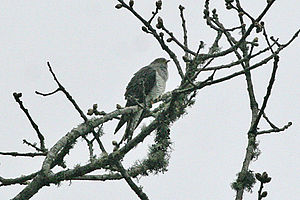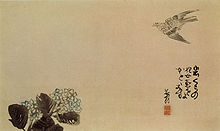Gackel Cuckoo
| Gackel Cuckoo | ||||||||||
|---|---|---|---|---|---|---|---|---|---|---|

Gackel Cuckoo ( Cuculus poliocephalus ) |
||||||||||
| Systematics | ||||||||||
|
||||||||||
| Scientific name | ||||||||||
| Cuculus poliocephalus | ||||||||||
| Latham , 1790 |
The lesser cuckoo ( Cuculus poliocephalus ), also known as Little Cuckoo or Rötelkuckuck called, belongs to the order of cuckoo birds (Cuculiformes) and the family of cuckoos (Cuculidae), a widely around the world bird family, whose most famous feature of the brood parasitism is.
The Gackel Cuckoo is a small, slender cuckoo with long narrow wings that breeds in the Palearctic and Oriental and overwinters in the Oriental and Afrotropic . Despite the very large distribution area, the species is monotypical . In females, however, there is a gray and a brownish color morph .
The gackle cuckoo is not a common bird in large parts of its range. But he is often in Nepal and Japan, for example, during the summer months. Overall, the stock situation is indicated with LC (= least concern - not endangered).
features
The gackling cuckoo reaches a body length of 25 centimeters and is one of the smaller cuckoos. The control springs account for about 12 centimeters of this. The beak is about 1.7 centimeters long. They weigh around 40 grams on average.
In the male, the plumage on the upper side of the body is predominantly gray-blue. The head, neck, throat and front chest are slightly lighter. In the direction of the upper tail-coverts, the tone of the plumage changes into a darker, almost blackish tone. The lower breast and the rest of the underside of the body is whitish with a dark sparrowth. The under tail coverts are reddish brown with a black sparrow coat. the stepped control springs are dark with white tips. The sparrow is wider than that of the European cuckoo .
The females of the gray color morph are similar to the males, but have a reddish tinge on the chest. The females of the brown color morph are reddish-brown on the upper side of the body with a fine black sparrowth, which is only missing on the rump. On the underside of the body they are whitish with a black sparrow coat. The control feathers are black and reddish-brown striped with white tips.
The cuckoo cuckoo has a dark brown iris and a yellow eye ring. The beak is black and turns yellowish to the base of the beak. The legs and feet are flesh-colored and yellowish.
The flight is fast and direct with flat wing beats and occasionally interrupted by short gliding phases. The call of the male is shrill and piercing and can be compared to the sound pattern with the syllable sequence kyo, kyo, kyo-kyo-kyo-kyo-kyo . The cuckoo cuckoo can be heard early in the morning, but it also sings at night.
Possible confusion
The lesser cuckoo is very similar to three other species of the genus Cuculus and is therefore difficult to identify in the field observation: Similar to him are also in Central Europe occurring cuckoo , the Hopfkuckuck and Madagascar cuckoo .
All three species are larger than the cuckoo cuckoo, the difference in size is the least pronounced compared to the Madagascar cuckoo. Compared to the cuckoo, the sparrowing of the gackle cuckoo is wider and less pronounced, but resembles that of the hopf cuckoo. In the Hopfkuckuck, however, the sparrows are usually missing on the lower tail-coverts. The Madagascar cuckoo has a stronger shade of brown on the chest.
distribution
The cuckoo cuckoo is a breeding bird in northeast Afghanistan, north Pakistan, Kashmir, Arunachal Pradesh , Nepal, Sikkim, Bhutan, Assam , in the Primorye region to the Bolshaya Ussurka river , in Sakhalin , in the north of Burma and Laos and in the west by Tonkin. In China, it breeds in the northeastern provinces of Hebei , Shandong , Shanxi , the south of Henan , Shaanxi , Gansu , Tibet , Sichuan , Yunnan , Guangxi , Guizhou , Zhejiang , Fujian and Guangdong . It also breeds in the two Korean states and Japan from the Izu Peninsula and Kyūshū to Hokkaidō . The bird can be found there from late April to September. This late return is an adaptation to the breeding season of the birds, in whose nests the Gackelguckuck lays its eggs. In addition, its preferred food in the northern areas is only sufficiently available at this time.
The breeding birds of Korea, China and Japan presumably overwinter in southern China, Cochinchinas , Annam and Burma, but a large part of the population migrates during the winter half-year over the Indian peninsula to Sri Lanka, where some of them winter from September to the end of April, as well as to the east of Africa.
In Africa the cuckoo cuckoo can be found from December to mid-April. The wintering areas include parts of the Democratic Republic of the Congo , Kenya , Malawi , South Africa , Tanzania , Zambia and Zimbabwe . During the migration, the cuckoo cuckoo apparently crosses the Indian Ocean , because it is not observed in the Middle East, but there are sightings in the Seychelles and Mauritius.
The cuckoo cuckoo is occasionally seen as a stray visitor in northern Thailand, Bangladesh, Uzbekistan, Turkmenistan and Somalia.
habitat
The cuckoo cuckoo uses light forests as preferred habitat, which are covered with birch, oak, maple and hornbeam. and have a lot of undergrowth. They like to stay at the edge of the forest and are particularly common in river valleys with wooded banks. In Africa, the cuckoo cuckoo can generally be found in more densely forested regions than the cuckoo. It also occurs there in pine plantations.
In the Himalayas, its altitude ranges up to 3600 meters. In Bhutan it occurs between 1000 and 2800 meters, but in Japan it rarely exceeds heights of 1200 meters.
Way of life
The cuckoo cuckoo feeds mainly on insects , especially caterpillars.
The cuckoo cuckoo is a breeding parasite that lays its eggs in the nests of songbirds . The preferred host birds include warbler and similar songbirds. The Japanese bush warbler is particularly common in Russia and Japan . Other common host birds include species from the genera Cettia , Phyolloscopus , Parus , Saxicola and Pnoepyga .
The breeding season in India falls from May to July, in South Korea from late May to early August and June and July in Japan. Its breeding season starts later compared to other cuckoos. The eggs of the gackling cuckoo are brown to reddish brown. There are no data on how long the eggs need to be incubated to hatch. The nestlings of the cuckoo cuckoo hatch naked and blind. At the age of two to three days, the nestling throws out the eggs and nestlings of its host parents. At nine days of age, the eyes open. The cuckoo cuckoo fledged on the 15th day of life.
Japanese culture

In Japan the gackling cuckoo is called Hototogisu ( 不如 帰 ). Unlike in Europe, where the bird does not appear, it has played a role as a literary motif in Japan and China since ancient times and has been given several names and spellings over the years.
The gackling cuckoo is found in Japan as a summer bird everywhere north of Kyushu . It is only rare on Kyūshū itself and on Hokkaidō , the northernmost of the Japanese main islands.
The name Hototogisu itself, like the German word cuckoo , comes from the male call, which sometimes sounds like ho-to-to-gi-su to Japanese ears : In Japan, too, the cuckoo calls out its own name.
Classical literature
Because of its singing, often referred to as “passionate”, the cuckoo cuckoo is the subject of numerous waka , traditional Japanese poems, today as in earlier times . This is already clear in Man'yōshū , the first large collection of Japanese poems. It often appears in poems together with the Stuffed Star Bush ( Deutzia scabra , jap. 卯 の 花 , u no hana ) or the wild mandarin ( Citrus tachibana , jap. 橘 , tachibana ), which begin to bloom at the same time as the Call of the gackling cuckoo sounds for the first time.
It is also valued as a bird singing at night. The first call of the cuckoo cuckoo in a year is shinobine ( 忍 び 音 , dt. About "soft sound"), which indicates that the first calls are still timid and quiet. In the so-called pillow book there is a description of staying awake at night with the intention of hearing the song of the cuckoo cuckoo before everyone else.
Since the Heian period , the cuckoo cuckoo was often written with the same characters as the common cuckoo (namely 郭 公 ), which was possibly due to the similarity of the birds. Also Matsuo Bashō , a famous Japanese haiku -Dichter the early Edo period , used these characters.
Legends and popular beliefs

Many of the Japanese legends relating to the gackle cuckoo go back to classical Chinese literature. In particular, the spellings 杜宇 , 蜀 魂 , 不如 帰 for Hototogisu have their origins in a Chinese legend according to which the emperor Dǜyǔ ( 杜宇 ) of the Chinese empire Shu ( 蜀國 ) falls in love with the wife of a follower, renounces the throne and the country left, but then supposed to have died in a foreign country. His soul is said to have turned into a cuckoo cuckoo and in memory of his homeland sent out the call bùrú guī ( 不如 歸 , Japanese reading: kaeru ni shikazu ), which he can still hear today.
Since the Edo period , the superstition arose in Japan that it was a bad omen to hear the call of the cuckoo cuckoo while staying in the toilet. The source for this is also of Chinese origin. These are the story collections Yǒuyáng zázǔ ( 酉陽 雑 俎 ) and Tàipíng guǎngjì ( 太平廣記 ).
Modern literature
In 1897 Masaoka Shiki founded the haiku magazine Hototogisu (Gackelkuckuck). Shiki also compared himself to this animal. From Tokutomi Roka a novel comes with the title Hototogisu .
literature
- Johannes Erhitzøe, Clive F. Mann, Frederik P. Brammer, Richard A. Fuller: Cuckoos of the World . Christopher Helm, London 2012, ISBN 978-0-7136-6034-0 .
- Paul A. Johnsgard: The Avian Brood Parasites - Deception at the Nest . Oxford University Press, Oxford 1997, ISBN 0-19-511042-0 .
- Kanouchi, Takuya and others: Nihon no yachō . Yama to Keikokusha, Tōkyō 1998, ISBN 4-635-07007-7 .
- Maki, Hirozō et al: Nihon no yachō 590 . Heibonsha, Tōkyō 2000, ISBN 4-582-54230-1 .
- Katō Tōru: Kairiki ranshin . Chūōkōronshinsha, Tōkyō 2007, ISBN 978-4-12-003857-0 .
Web links
- Photo of a gackling cuckoo
- Cuculus poliocephalus in the endangered Red List species the IUCN 2008. Posted by: BirdLife International, 2008. Accessed on December 15 of 2008.
- Voice of the cuckoo cuckoo on Xeno-Canto
Single receipts
- ↑ a b c Erhitzøe, Mann, Brammer, Fuller: Cuckoos of the World . P. 455.
- ↑ Cuculus poliocephalus in the endangered Red List species the IUCN 2008. Posted by: BirdLife International, 2008. Accessed August 20, 2016th
- ↑ a b c d e f g Erhitzøe, Mann, Brammer, Fuller: Cuckoos of the World . P. 456.
- ↑ Erhitzøe, Mann, Brammer, Fuller: Cuckoos of the World . P. 457.